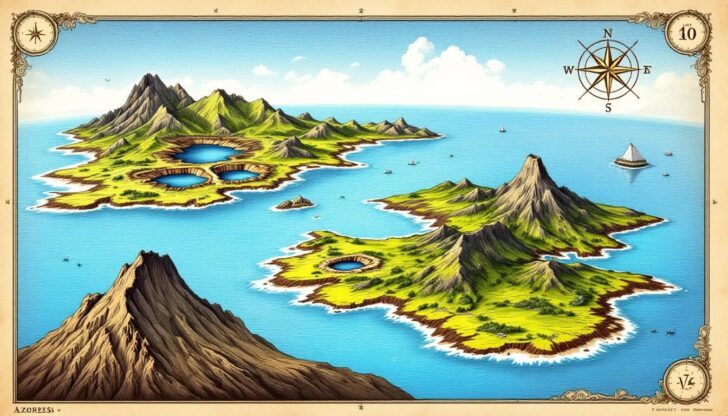Mid Atlantic countries include regions from North America’s Mid-Atlantic states, such as Delaware, Maryland, New Jersey, New York, Pennsylvania, Virginia, and West Virginia, to European territories like the Azores and Canary Islands. This article provides an overview of their geographies, cultures, and historical significance.
Table of Contents
Key Takeaways
The Mid Atlantic region encompasses diverse states and islands, serving as a cultural and geopolitical bridge between continents.
Key historical influences from the United Kingdom, Portugal, and Spain have shaped the region’s maritime trade, exploration, and cultural landscape.
The Mid Atlantic islands, including the Azores, Canary Islands, and Madeira, are vital for biodiversity, tourism, and cultural heritage, enhancing the region’s economic and ecological importance.
Overview of Mid Atlantic Countries
Spanning from bustling metropolises to tranquil islands, the Mid Atlantic region is a tapestry of diverse geographies and cultures. This region includes the middle Atlantic states of Delaware, Washington, Maryland, New Jersey, New York, Pennsylvania, Virginia, and West Virginia, covering an approximate area of 191,308 square miles. The population density is about 300 people per square mile, reflecting the blend of urban hubs and city rural expanses. Notably, New York City, the largest city in this region, boasts a population of over 8.6 million, underscoring its importance as a major urban center. This region’s significance is not just in its landmass but in its role as a bridge between continents and cultures.
The Mid Atlantic’s strategic position has made it a focal point for historical voyages, such as those led by Spain, which mapped and enhanced our understanding of the region’s geographic importance. From the early days of exploration to the current era of globalization, the Mid Atlantic region continues to play a vital role in connecting the old world with the new.
Key Nations in the Mid Atlantic Region
Several key nations have left indelible marks on the Mid Atlantic region’s history and development. The United Kingdom, Portugal, and Spain are three such nations that have played pivotal roles in maritime exploration and trade, shaping the region’s geopolitical landscape.
The United Kingdom’s connection is rooted in naval prowess and colonial activities, Portugal’s heritage is highlighted by strategic archipelagos and exploration, and Spain’s territories and exploration efforts continue to influence the region.
United Kingdom
The United Kingdom’s ties to the Mid Atlantic are steeped in a legacy of exploration and colonization. British naval power and trade established critical connections across the Atlantic region, enhancing its geopolitical influence. The UK’s strategic goals often aimed to prevent any single continental power from dominating Europe, shaping its involvement in Mid Atlantic affairs. This context underscores the UK’s lasting influence here.
Britain’s early exploration set the stage for its geopolitical strategies, with naval power and global trade connections maintaining its significant role. This legacy continues to impact modern-day geopolitics and trade routes.
Portugal
Portugal’s maritime legacy underpins its historical significance, with a rich history of exploration and trade leaving a lasting cultural and political presence.
The Azores, a critical archipelago of Portugal, serve as a strategic point in the Mid Atlantic, enhancing its maritime influence. These islands have been vital in maritime navigation and cultural exchange, highlighting Portugal’s enduring impact on the Atlantic.
Spain
Spain’s exploration during the Age of Discovery established territories, showcasing its maritime prowess. The Canary Islands, a significant Spanish territory, have been pivotal in agricultural and resource exploitation, contributing to Spain’s economic activities in the region. These efforts highlight Spain’s lasting influence.
Modern Spain asserts its relevance through economic activities and cultural ties with islands like the Canary Islands. The region’s agricultural and resource exploitation has been central to Spain’s economic strategy, highlighting the ongoing importance of these territories.
The Mid Atlantic Islands

The Mid Atlantic islands, including the Azores, Canary Islands, and Madeira, are cultural and biological treasures with unique features contributing to the region’s diversity and appeal, playing significant roles in navigation, cultural exchange, and tourism.
The Azores, nine islands in the Atlantic, are known for unique geological features and rich biodiversity. The Canary Islands, with their distinct volcanic landscapes, attract millions of tourists each year. Madeira, renowned for its wine production and breathtaking natural scenery, is a popular destination for travelers.
Azores
The Azores are a testament to nature’s volcanic artistry, featuring stunning landscapes and diverse ecosystems. This archipelago, consisting of nine major islands, is characterized by its mild temperatures and unique volcanic landscapes. Their volcanic origins contribute to breathtaking beauty and biodiversity.
These islands are visually stunning and ecologically significant. The Azores boast lush landscapes and unique ecosystems that host diverse wildlife. These volcanic origins and ecosystems make the Azores a biodiversity hotspot, attracting nature enthusiasts and researchers.
Canary Islands
The Canary Islands attract tourists seeking relaxation and adventure. Known for their hot summers and mild winters, these islands cater to diverse tourist experiences, from sunbathing on sandy beaches to hiking volcanic terrains. The distinct volcanic landscapes of the Canary Islands are a significant draw for visitors, offering a blend of natural beauty and adventure.
Their appeal lies in offering something for everyone. With volcanic terrains and vibrant culture, the Canary Islands attract many tourists yearly. This blend of natural beauty and cultural richness makes the Canary Islands a unique and popular destination.
Madeira
Madeira is famous for wine production and stunning natural scenery. The island’s mild climate and breathtaking landscapes make it a renowned tourist destination. Madeira wine, a fortified wine known for its rich flavor and unique aging process, is a highlight for many visitors.
Favorable climate and scenic beauty make Madeira a must-visit.
Economic Importance of the Mid Atlantic Region
The Mid Atlantic region connects Europe and the Americas, influencing trade, culture, and geopolitics. Historically, its strategic location has made it essential for diverse economic activities, shaping early American history. Panama Canal expansion is expected to increase ship traffic and trade at Mid Atlantic ports, leading to job growth.
The total non-market economic value of the nation’s ocean and coastal resources is estimated at over $100 billion per year. The region’s rich tapestry of cultural influences enhances its tourism appeal, with local festivals often celebrating seafood and the region’s fishing heritage.
Job growth related to port improvements underscores the region’s economic importance.
Historical Significance of the Mid Atlantic Region
Significant historical and cultural influences from key nations have shaped the Mid Atlantic region. During the Age of Exploration, the middle atlantic region served as a crucial area for European powers seeking new trade routes and territories. The region’s cultural heritage is deeply influenced by historical maritime communities and traditions in fishing and trade.
Cultural events in the Mid Atlantic celebrate community diversity. From the bustling ports that played crucial roles in maritime trade history to the vibrant cultural festivals, the historical significance of the Mid Atlantic is reflected in its enduring cultural heritage.
Age of Exploration
The Age of Exploration defined the Mid Atlantic, with Portugal and Spain playing significant roles. Portuguese explorers established key island colonies, pivotal for trade and navigation. Spain’s voyages established territories critical for transatlantic trade and cultural exchange.
Christopher Columbus’s 1492 voyages marked the start of significant European exploration and colonization in the Americas. Following Columbus, Spanish explorers aimed to establish settlements and find a passage to Asia.
The Mid Atlantic is home to significant historical sites, including ports that played crucial roles in the region’s maritime trade history.
Colonial Influence
Colonial influence in the Mid Atlantic involved significant exploration and establishment of trade routes. Spain’s exploration established territories that contributed to its empire and influenced European power dynamics.
The Columbian Exchange caused significant demographic changes, notably the dramatic decline in Native American populations due to disease.
Environmental and Geological Features
The Mid Atlantic’s environmental and geological features are as diverse as its cultural heritage. The ocean economy of the Mid Atlantic contributed approximately $47 billion to the national GDP in 2012, with the largest contribution from tourism and recreation.
Offshore wind energy development could create significantly more jobs and energy than traditional oil and gas production. Offshore wind energy facilities could generate double the jobs and energy compared to conventional oil and gas. This emphasis on sustainable energy highlights the region’s commitment to environmental conservation and economic growth.
Mid-Atlantic Ridge
The Mid-Atlantic Ridge, formed by the divergent movement of the North American and Eurasian Plates, as well as the African and South American Plates, is a fascinating geological feature. This ridge features a rift valley at its peak where the tectonic plates diverge and magma rises, leading to volcanic activity and the creation of basaltic formations. In the South Atlantic, the Mid-Atlantic Ridge separates the South American Plate from the African Plate, highlighting the dynamic nature of the Earth’s crust in this region.
Sea floor spreading at the Mid-Atlantic Ridge creates new oceanic lithosphere, gradually widening the Atlantic Ocean. This geological activity is a testament to the dynamic nature of our planet, constantly reshaping the ocean floor and contributing to the rich biodiversity of the region.
Biodiversity
The Mid Atlantic islands are home to a wide variety of unique species that contribute to their rich biodiversity. The Azorean waters have established the largest marine protected area network in Europe, covering 287,000 square kilometers. Conservation efforts in the Mid Atlantic region aim to protect these diverse ecosystems from habitat loss and climate change.
Endemic species on the Mid Atlantic islands face threats from habitat loss and invasive species. Conservation strategies aim to protect habitats from urban development and climate change, ensuring regional biodiversity sustainability.
Cultural Heritage and Tourism
The Mid Atlantic has shaped American culture through historical events and a diverse population. The major cities in the Mid Atlantic, such as New York City, Philadelphia, and Baltimore, have played significant roles in urban development and historical significance, contributing to the region’s diversity and growth over time. The Mid Atlantic Islands, including the Azores, Canary Islands, and Madeira, attract visitors with unique ecosystems and rich cultural heritage.
Projected population growth along the Mid Atlantic coast is expected to boost travel, tourism, and recreation. This growth will likely drive economic expansion in these sectors, highlighting the region’s importance as a cultural and tourist hub.
Natural beauty and rich cultural heritage make the Mid Atlantic a unique destination for global travelers.
Festivals and Traditions
Summer in the Mid Atlantic features various seasonal festivals, including art, music, and food celebrations. Events like the Havre de Grace Jazz and Blues Festival and the Mid-Maryland Celtic Festival celebrate musical heritage and attract many visitors.
Maryland hosts ethnic festivals like the Caribbean Carnival in Baltimore and the Kunta Kinte Heritage Festival in Annapolis, showcasing cultural diversity.
Tourist Attractions
The Canary Islands, comprising seven main islands, draw around 16 million tourists annually with their favorable climate and natural beauty. With hot summers and mild winters, the Canary Islands offer a year-round destination for sun-seeking tourists. This climate and scenic landscape combination makes the Canary Islands a prime location for European tourists.
Madeira is renowned for its excellent wine production, especially the fortified Madeira wine with its rich history and distinct flavors. A prime cruise destination, Madeira attracts about half a million visitors annually for its wine and scenic walks.
Natural attractions like beaches and parks in the Mid Atlantic region offer ample outdoor recreation, enhancing its appeal.
International Relations and Cooperation
The Mid Atlantic has been central to key U.S. historical events, including the signing of the Declaration of Independence. European powers’ competition for control over Mid Atlantic territories shaped the region’s geopolitical landscape.
This context continues to influence modern international relations and cooperation among Mid Atlantic countries, underscoring the region’s global significance.
Summary
In conclusion, the Mid Atlantic region is a vibrant mosaic of historical significance, cultural richness, and economic importance. From the strategic roles of key nations like the United Kingdom, Portugal, and Spain, to the breathtaking beauty of the Mid Atlantic islands, the region continues to captivate and inspire. Its unique blend of natural wonders, rich biodiversity, and cultural heritage makes the Mid Atlantic a pivotal area in global affairs. As we look to the future, the region’s commitment to sustainability and conservation will ensure that its treasures are preserved for generations to come.
Frequently Asked Questions
What states were in the Mid Atlantic colonies?
The Mid Atlantic colonies included New York, New Jersey, Pennsylvania, and Delaware. These states were known for their diversity in population, religion, and economy.
What countries are transatlantic?
The transatlantic countries primarily include the United States, Canada, the European Union member states, and the United Kingdom. Other European nations, Latin America, and Africa are not typically classified as part of transatlantic relations.
What is considered the mid-Atlantic?
The Mid-Atlantic region primarily comprises Delaware, Maryland, New Jersey, New York, Pennsylvania, and the District of Columbia. This area is recognized as part of the larger Northeast region of the United States.
What are the key features of the Mid-Atlantic Ridge?
The Mid-Atlantic Ridge is characterized by a rift valley created by the divergent movement of tectonic plates, where magma ascends, leading to volcanic formations and the progressive widening of the Atlantic Ocean.
What makes the Canary Islands a popular tourist destination?
The Canary Islands are a popular tourist destination because of their appealing climate, featuring hot summers and mild winters, alongside unique volcanic landscapes that provide diverse experiences for visitors.









